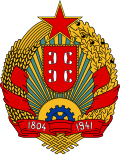Socialist Republic of Serbia
| Socijalistička Republika Srbija | |||||
| Socialist Republic of Serbia | |||||
| 1943-1990 | |||||
|
|||||
| Official language | Serbo-Croatian | ||||
| Capital | Belgrade | ||||
| surface | 88361 km² | ||||
| currency | Yugoslav dinar | ||||
| Time zone | UTC +1 | ||||
The Socialist Republic of Serbia ( Serbo-Croatian Socijalistička Republika Srbija / Социјалистичка Република Србија ; by 1963 People's Republic of Serbia , Serbo-Croatian Narodna Republika Srbija / Народна Република Србија ) was from 1943 to 1990, a constituent republic of the Socialist Federal Republic of Yugoslavia . It was the largest and most populous republic in terms of area and its capital, Belgrade, was also the capital of the SFR Yugoslavia. Measured in terms of the share of Yugoslavia's gross domestic product , Serbia, including its autonomous provinces of Vojvodina and Kosovo, was the republic with the highest economic output and ranked third among the republics in terms of GDP per capita . It was the predecessor of the modern state of Serbia and was ruled by the Union of Communists of Serbia .
history
During the Second World War , Yugoslavia was re-established as a socialist state on November 29, 1943 . The People's Republic of Serbia became one of six constituent republics in Yugoslavia. With the constitution of 1963 it was - like the other republics - renamed the "Socialist Republic". In 1974 the rights of the two autonomous provinces of Vojvodina and Kosovo , which had already existed since the Yugoslav constitution of 1946, were significantly expanded, so that they were given extensive political independence.
After Tito's death in 1980 and the rise of Albanian and Serbian nationalism in Kosovo, there were disagreements in the Communist League on how to respond. A group led by Slobodan Milošević supported the Serbian nationalists in Kosovo to revoke its autonomy.
In 1989 Milošević took over the presidency of the Republic of Serbia and was confirmed in office in 1990 in the first free elections since World War II with 65 percent of the vote. One of the first official acts was the lifting of autonomy for the provinces of Kosovo and Vojvodina as part of the “ anti-bureaucratic revolution ”. As a result, there was severe ethnic tensions and finally the collapse of the Union of Communists of Yugoslavia and of Yugoslavia in 1991.
After 1990 the state was referred to as Republika Srbija ( Republic of Serbia ), which was part of the Federal Republic of Yugoslavia until 2003 , then as Serbia and Montenegro from 2003 until 2006, when the federation with Montenegro was dissolved.
population
At the 1971 census , the total population was 8,446,591. The largest population groups were: 6,142,071 Serbs (72.71%), 984,761 Albanians (11.66%), 430,314 Hungarians (5.10%), 184,913 Croats (2.19%), 154,330 Muslims (1.83 %) and 123,824 Yugoslavs (1.47%).
At the 1981 census, the total population was 9,313,677 and consisted of the following ethnic groups: 6,331,527 Serbs (67.96%), 1,303,032 Albanians (13.99%), 441,941 Yugoslavs (4.75%), 390,468 Hungarians (4.19%) and 215,166 Muslims (2.31%).
politics
Political structure
Two autonomous provinces, Vojvodina and Kosovo, existed within the Socialist Republic of Serbia since 1974 . The intermediate region of Central Serbia (also called Narrow Serbia ) did not have its own administrative administration and was directly under the government of the SR Serbia. With the exception of the controversial declaration of independence from Kosovo in 2008, this also corresponds to the political structure of today's Republic of Serbia.
President
The following people were President of SR Serbia:
- Siniša Stanković (April 7, 1945 - March 1953)
- Petar Stambolić (December 1953 - April 1957)
- Jovan Veselinov (April 1957 - June 26, 1963)
- Dušan Petrović (June 26, 1963 - May 6, 1967)
- Miloš Minić (May 6, 1967 - May 6, 1969)
- Dragoslav Marković (May 6, 1969 - April 19, 1974)
- Živan Vasiljević (April 19 - May 6, 1974)
- Dragoslav Marković (May 6, 1974 - May 5, 1978)
- Dobrivoje Vidić (May 5, 1978 - May 5, 1982)
- Nikola Ljubičić (May 5, 1982 - May 5, 1984)
- Dušan Čkrebić (May 5, 1984 - May 5, 1986)
- Ivan Stambolić (May 5, 1986 - December 14, 1987)
- Petar Gračanin (December 14, 1987 - March 20, 1989)
- Ljubiša Igić (March 20 - May 8, 1989) (acting)
- Slobodan Milošević (May 8, 1989 - September 28, 1990)
prime minister
The following persons were Prime Ministers of SR Serbia:
- Jaša Prodanović (March 7, 1945 - April 9, 1945)
- Blagoje Nešković (April 9, 1945 - September 5, 1948)
- Petar Stambolić (September 5, 1948 - December 16, 1953)
- Jovan Veselinov (December 16, 1953 - April 6, 1957)
- Miloš Minić (April 6, 1957 - June 9, 1962)
- Slobodan Penezić Krcun (June 9, 1962 - November 6, 1964)
- Stevan Doronjski (November 6, 1964 - November 17, 1964) (acting)
- Dragi Stamenković (November 17, 1964 - June 6, 1967)
- Đurica Jojkić (June 6, 1967 - May 7, 1969)
- Milenko Bojanić (May 7, 1969 - May 6, 1974)
- Dušan Čkrebić (May 6, 1974 - May 6, 1978)
- Ivan Stambolić (May 6, 1978 - May 5, 1982)
- Branislav Ikonić (May 5, 1982 - May 6, 1986)
- Desimir Jevtić (May 6, 1986 - December 5, 1989)
- Stanko Radmilović (December 5, 1989 - September 28, 1990)
See also
Individual evidence
- ↑ Tobias Pflüger , Martin Jung, Krieg in Yugoslavien , 2nd edition 1994, ISBN 3-9803269-3-4 , p. 29




